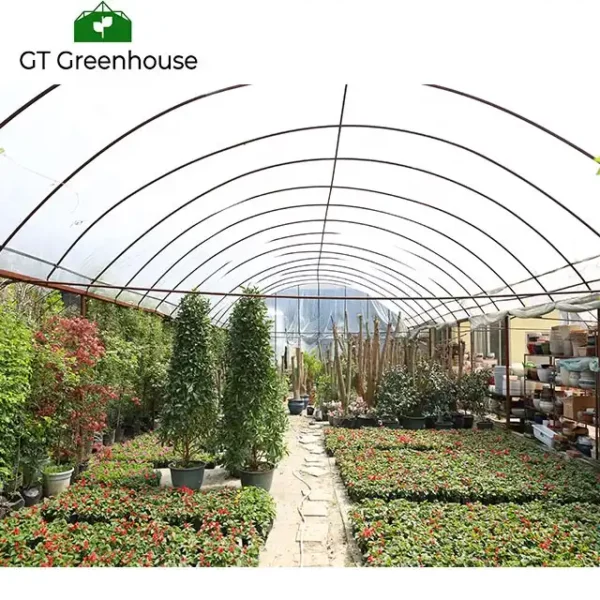Agricultural tomato greenhouses offer several benefits compared to open-field cultivation.
Here are some of the advantages of growing tomatoes in a greenhouse:
- Extended Growing Season: Greenhouses provide a controlled environment that allows for an extended growing season. Tomatoes can be cultivated earlier in the spring and continue producing well into the fall or even year-round in some regions. This enables farmers to have a more consistent and continuous tomato supply, resulting in better market opportunities and increased profitability.
- Climate Control: Greenhouses enable precise control over temperature, humidity, and ventilation, creating an optimal microclimate for tomato plants. This control allows growers to create the ideal conditions for tomato growth, ensuring optimal yields, improved quality, and reduced risks associated with adverse weather conditions, such as frost, excessive heat, or heavy rains.
- Protection from Pests and Diseases: Greenhouses act as a physical barrier, protecting tomato plants from various pests, insects, and diseases. By minimizing exposure to external factors, greenhouse cultivation reduces the risk of crop damage and the need for chemical pesticides. This can lead to healthier plants and safer produce.
- Increased Yield and Quality: The controlled environment in a greenhouse provides tomatoes with optimal conditions for growth, resulting in higher yields and better-quality produce. Growers can fine-tune factors such as lighting, temperature, irrigation, and nutrient delivery, giving plants the ideal conditions to thrive. As a result, greenhouse-grown tomatoes often have better flavor, size, color, and overall market appeal.
- Water and Resource Efficiency: Greenhouses allow for efficient water and resource management. Watering systems can be optimized to minimize water usage and reduce waste through methods such as drip irrigation or hydroponics. Additionally, the controlled environment helps conserve resources like fertilizers and energy by optimizing their usage and reducing losses.
- Crop Protection: Greenhouses offer protection against adverse weather conditions, such as strong winds, hail, or heavy rains, that can damage or destroy tomato crops. This protection minimizes crop losses and ensures a more reliable and consistent harvest.
- Flexibility in Variety Selection: Greenhouses provide the opportunity to grow a wide range of tomato varieties, including heirloom or specialty varieties that may not be suitable for open-field cultivation. This allows growers to diversify their offerings and cater to specific market demands, expanding their business opportunities.
- Improved Plant Health and Uniformity: The controlled environment in a greenhouse promotes healthier plant growth and uniformity. Factors such as temperature, humidity, and lighting can be optimized to reduce stress on the plants, resulting in more robust and uniform growth. This can lead to easier management, improved productivity, and overall better crop performance.
It’s important to note that greenhouse cultivation requires initial investment in infrastructure, equipment, and ongoing management. However, the benefits mentioned above often outweigh the costs, making agricultural tomato greenhouses a popular choice for commercial tomato production.
Can you provide examples of regions where greenhouse tomato cultivation is particularly popular?
Greenhouse tomato cultivation is popular in various regions around the world.
Here are some examples:
- The Netherlands: The Netherlands is renowned for its advanced greenhouse horticulture industry. Dutch growers have mastered the art of high-tech greenhouse cultivation, including tomatoes. The country’s favorable climate and expertise in greenhouse technology have made it a major producer and exporter of greenhouse-grown tomatoes.
- Spain: Spain is another significant player in greenhouse tomato production. Regions such as Almería, Murcia, and Valencia are known for their extensive greenhouse complexes. Spain’s mild climate and ample sunlight make it suitable for year-round tomato cultivation, meeting both domestic and international market demands.
- Canada: In Canada, greenhouse tomato cultivation has gained prominence, especially in regions with colder climates. Provinces like Ontario and British Columbia have seen significant growth in greenhouse vegetable production, including tomatoes. The use of advanced greenhouse technology and climate control systems allows for year-round cultivation despite the harsh Canadian winters.
- United States: Greenhouse tomato production is widespread across the United States, particularly in states with diverse climates. Regions such as California, Arizona, Texas, and Florida have suitable conditions for greenhouse cultivation and are known for their significant tomato production.
- Mexico: Mexico has emerged as a major greenhouse tomato producer and exporter. States like Sinaloa, Sonora, and Baja California have favorable climates for greenhouse cultivation, allowing for year-round production. Mexican tomatoes are often supplied to the North American market during winter months when local production is limited.
- China: China has witnessed substantial growth in greenhouse tomato production. The country’s vast agricultural sector and increasing demand for high-quality produce have led to the expansion of greenhouse cultivation, including tomatoes. Regions such as Shandong, Hebei, and Xinjiang are known for their significant greenhouse tomato production.
- Middle East: In the arid regions of the Middle East, such as the United Arab Emirates, Qatar, and Saudi Arabia, greenhouse tomato production has gained traction. The use of advanced greenhouse technologies, including desalination systems and climate control, allows for year-round cultivation despite the challenging climatic conditions.
These are just a few examples of regions where greenhouse tomato cultivation is particularly popular. However, greenhouse tomato production can be found in many other countries worldwide, as it offers growers the ability to overcome limitations imposed by climate and seasonality, ensuring a consistent supply of fresh tomatoes throughout the year.
